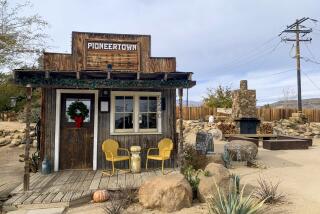Ghosts of Bodie: A Town Where Gold No Longer Glitters
- Share via
One morning on my fishing trip in the Sierra with my son and two grandsons, we drove to Bodie, the famous ghost town in Mono County, on a desert mountainside above Mono Lake.
Bodie is as authentic as a ghost town can be. Its structures number only 5% of those standing in the 1880s, when Bodie had 10,000 residents and was notorious for its wickedness and bad weather.
Bodie has had no residents since World War II. It had been ravaged by vandals, but in 1962 it was named a state historic park. Today it survives in a state of “arrested decay,” protected by live-in rangers.
It has no concessions. No Cokes, no candy, no post cards. Its only public facilities are a drinking fountain and two unisex toilets, used by both sexes, one at a time.
Its rough pine buildings are ramshackle and askew, but enough remain to suggest the life its residents led. The Methodist Church still stands, with its pitched roof and rude cross. Its hard wooden pews must have offered little comfort to the faithful. The Ten Commandments, painted on oilcloth, once hung above the pulpit. The work was stolen, despite its commandment against theft.
One may walk along the dirt streets and peer through windows into the crude interiors of houses and public buildings. Life must have been unimaginably hard. The temperature sometimes reached 40 degrees below zero, with winds of 100 miles an hour.
The schoolhouse remains as a testament to the American belief in public education, however difficult the circumstances. Rows of desks may still be seen. Maps of the world cover one wall. One wonders what the schoolteacher’s life was like.
Life was short and hard. Disease was prevalent. In the boom years Main Street was filled with rotting garbage. The mortician’s plumed hearse made two or three trips daily to the nearby graveyard. But women and children seemed more resistant than men. The town’s few doctors, despite their dedication, were regarded as part of the problem.
There were 65 saloons. Workers from the nearby gold mines crowded into the saloons to drink, fight and gamble. Shootings were common. The red light district was known as Virgin Avenue. Its residents often engaged in fisticuffs with their customers or each other, to the delight of local journalists.
Eleanor Dumont, a gambler, was known to almost every mining camp in the West. When she arrived in Bodie she was no longer young, but still attractive. When she failed at gambling, she turned to prostitution. One night in 1879 she borrowed $300 from a friend and opened a faro bank. In a few hours she was broke. In the morning her body was discovered in sagebrush out of town. She had commited suicide.
Like every town in the West, Bodie had its journalists who covered it, in the manner of Mark Twain, with hyperbolic humor. They were quick to defend the town’s reputation. When a Truckee paper reported that a little girl ended her prayer with “Goodby, God. We’re going to Bodie,” a Bodie paper responded that what the little girl had really said was “Good, by God! We’re going to Bodie!”
Bodie was named for William S. Body, one of a party of prospectors who discovered gold at the site in 1859. They built a cabin. In the winter of 1860 Body and Black Taylor got caught out in a blizzard. Body collapsed. Taylor tried to carry him but gave up. He wrapped him in a blanket for the night. In the morning he couldn’t find him. It was not until spring that Body’s body was found. Taylor and his friends buried him in a shallow grave.
Twenty years later the grave was discovered and what the animals had left of Body was buried in Bodie cemetery. In time the town raised money for a monument. Before it was erected, President Garfield was assassinated, and it was erected in his memory instead.
Bodie was full of homeless panhandlers. The gold strike brought in thousands of men, some on foot, looking for work. The mines could hire only a few. A newspaper said, “They sleep in chairs until the saloons close up, and then walk the streets until morning.”
Lumber and other supplies were hauled in by 16-mule teams. Daily six-horse stagecoaches brought in newcomers. Gold bullion was shipped out by Wells Fargo Express. One shipment of $500,000 was guarded by six Wells Fargo messengers--two on horseback in front of the stage, two in back, and two inside. During its productive years Bodie shipped out $100 million in gold.
Bodie’s worst enemy was not weather and badmen but fire. Coal oil lamps, dry pine walls and arsonists heightened the danger. Despite a vigilant fire-fighting system, disastrous fires ravaged the town in 1892 and in 1932.
Our forebears were made of hardy stuff.
More to Read
Sign up for Essential California
The most important California stories and recommendations in your inbox every morning.
You may occasionally receive promotional content from the Los Angeles Times.













